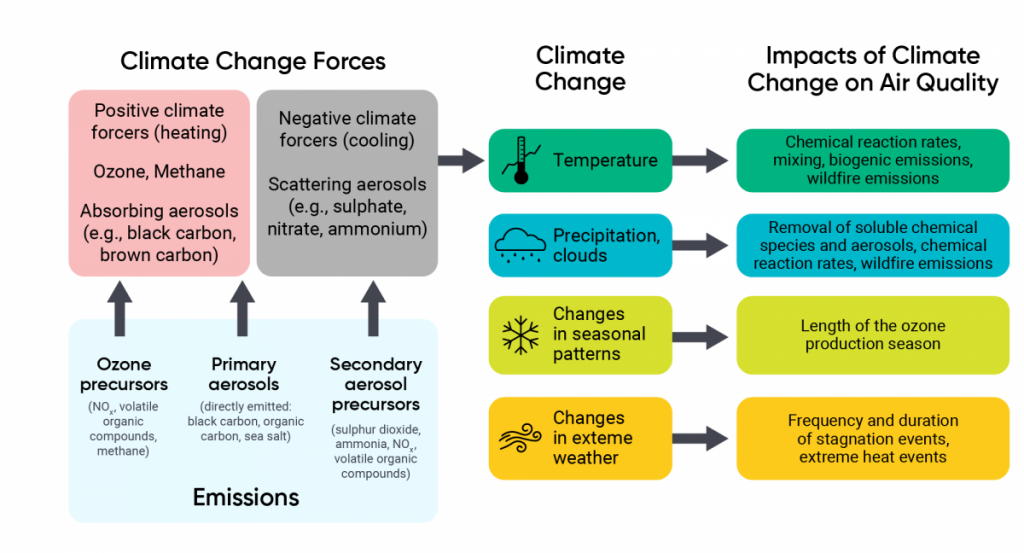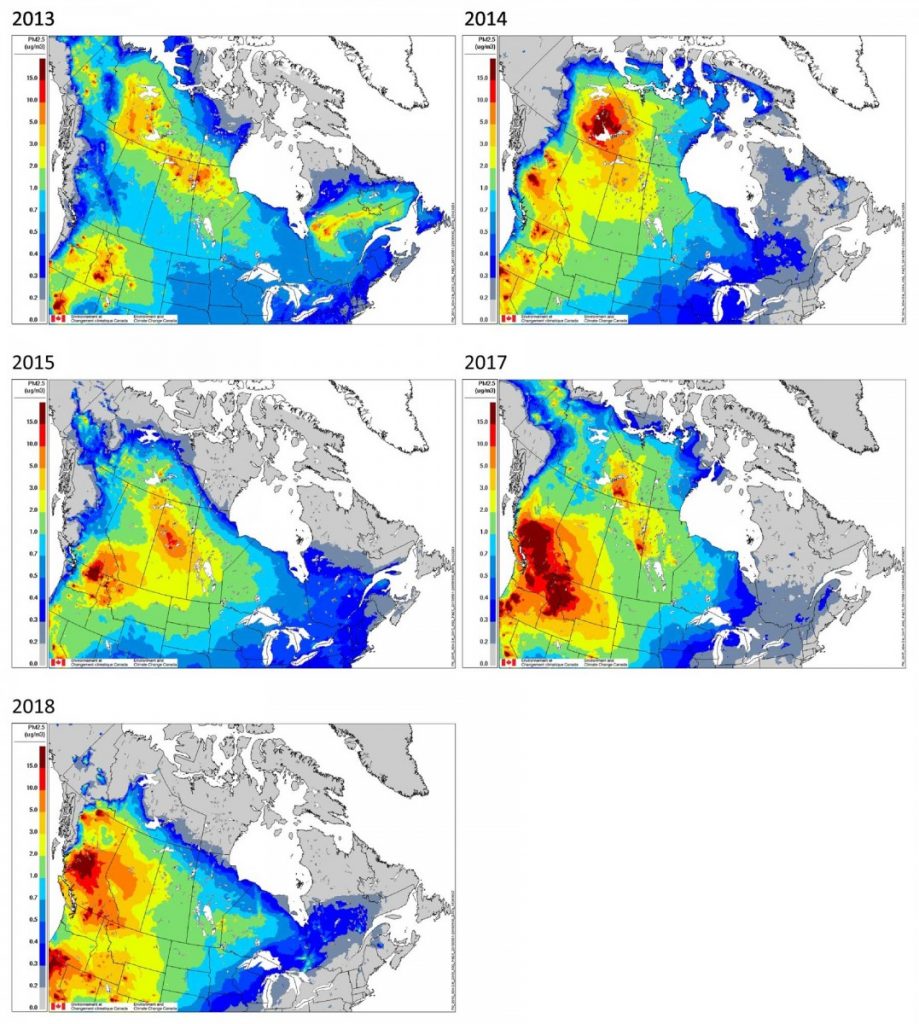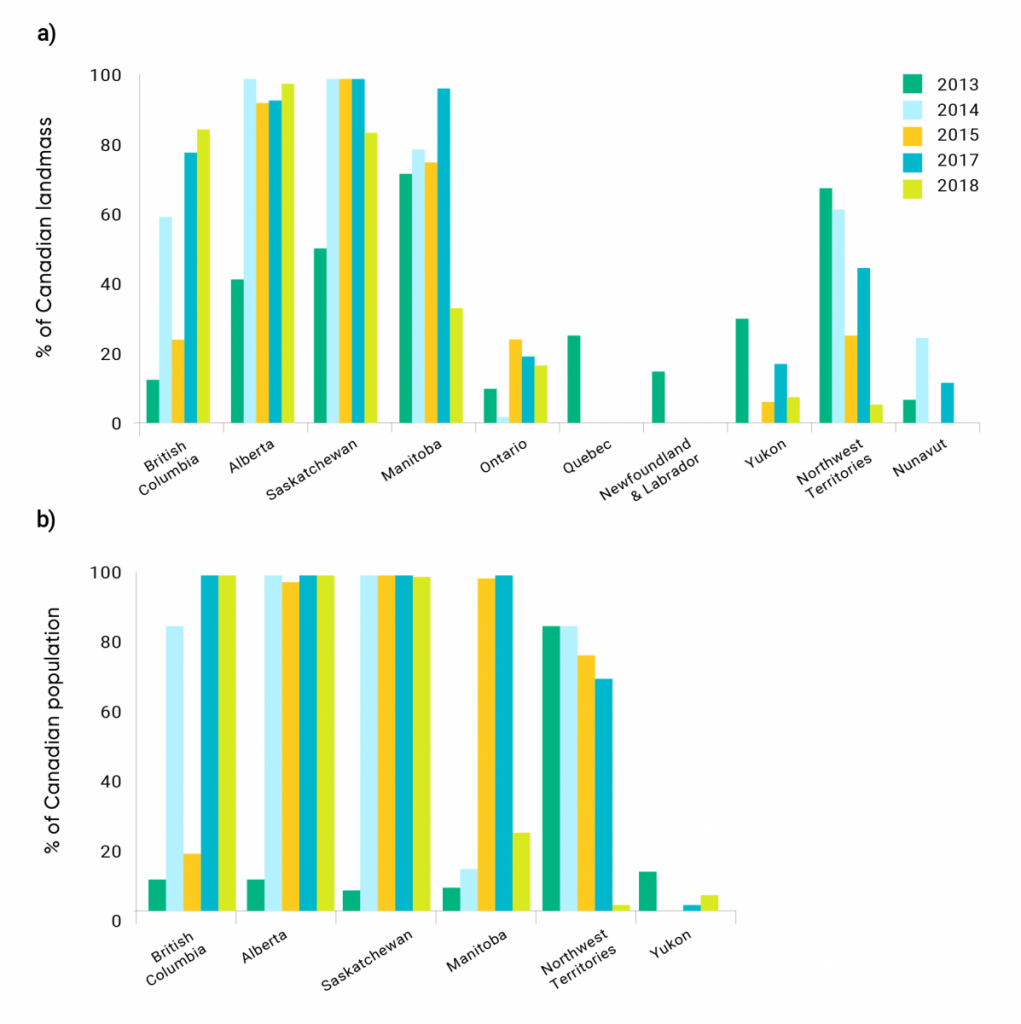Mitigation measures to reduce GHGs and SLCFs help stabilize the climate by reducing pollutants that play a role in increasing global temperature and accelerating climate change. However, climate change mitigation strategies can also have a range of indirect health co-benefits (Markandya et al., 2018). Key among these are health co-benefits from reductions in air pollution because of the following: climate mitigation will limit the climate penalty; some climate pollutants (e.g., black carbon, ozone) contribute to air pollution either directly or as precursors; and changes in industrial and transportation activities to reduce long-lived GHG and/or SLCF emissions can also reduce co-emitted conventional air pollutants (Smith et al., 2014). For example, the widespread use of electric vehicles powered by low-carbon energy can be a strategy for GHG mitigation that could also result in improved air quality. Consequently, climate change mitigation measures represent an opportunity to integrate objectives to stabilize the climate with those to reduce air pollution health impacts, which may offset the costs of implementing the measures (Thompson et al., 2016).

Studies examining air pollution health co-benefits associated with GHG mitigation strategies typically compare a policy scenario that includes strong GHG mitigation and accompanying reductions in air pollutant emissions with a scenario with limited GHG mitigation and associated higher air pollutant emissions. Economic valuation of air pollution health co-benefits allows co-benefits to be incorporated into a broader climate change framework, and the cost-effectiveness and potential optimization of various GHG mitigation measures, which can impose an economic burden on society, can be examined. Studies report monetized health co-benefits as total dollar value or as the marginal benefit per tonne of CO2 equivalent that is reduced. Both PM2.5– and ozone-related health co-benefits have been evaluated in the studies reviewed below, unless otherwise stated.
In a global analysis of GHG mitigation measures associated with RCP4.5, it was estimated that Canadian air pollution health co-benefits would range from about 4500 to 6500 avoided premature deaths annually between 2030 and 2100, relative to the reference scenario associated with the RCP projections (West et al., 2013) (Table 5.2). US co-benefits were estimated to be about an order of magnitude higher (West et al., 2013; Zhang et al., 2017). Globally, changes in emissions were estimated to avoid 0.5 million, 1.3 million, and 2.2 million deaths from combined exposure to ozone and PM2.5 in 2030, 2050, and 2100, respectively. The global average monetized marginal health co-benefits were estimated to be $50 to $380 per tonne of CO2 (tCO2) (in 2005 USD), which exceed the marginal GHG abatement costs in 2030 and 2050 in this analysis, and partially offset the costs in 2100 (West et al., 2013). For the United States, the marginal value of avoided ozone- and PM2.5-related deaths was estimated to be $45 to $137/tCO2 (in 2005 USD) (Zhang et al., 2017).
Other studies have evaluated the avoided air pollution deaths associated with climate mitigation pathways based on specific targets for increases in global mean surface temperature in the future compared to a reference scenario. The US air pollution heath co-benefits of reducing the climate penalty were estimated for two climate mitigation scenarios, reflecting a 2.5°C and 2.0°C increase in global mean surface temperature (Saari et al., 2019). The two mitigation scenarios reduced the combined ozone and PM2.5 health impacts by thousands and tens of thousands of deaths in 2050 and 2100, respectively, with 40% greater PM2.5 benefits by 2100, under the more stringent policy compared to the less stringent policy. In 2100, air pollution (ozone and PM2.5) risks associated with climate change were attenuated by 70% to 88% in the policy scenarios. Similarly, US health co-benefits of limiting global warming in 2100 to a 1.5°C rise was estimated to result in 11,000 and 52,000 avoided premature deaths across the United States in 2050 and 2100, respectively, compared to a reference scenario with a 6°C increase in global mean surface temperature. These health co-benefits were valued at 150 billion USD and 1.3 trillion USD (in 2005 USD), respectively, which were equivalent to a rate of $25 (95% CI $9–$42) per tonne of CO2 equivalent (tCO2e) and $122 (95% CI $45–$207)/tCO2e, respectively (Garcia-Menendez et al., 2015).
In a global analysis, Vandyck et al. (2018) examined the air quality implications in 2100 of two GHG mitigation scenarios, the first based on GHG emission reductions implied by the Nationally Determined Contributions, leading to a 2.5°C to 3.2°C rise in global mean temperature by 2100, and the second a 2°C rise by 2100. Globally, avoided deaths due to air pollution in 2050 were estimated at 0.3 to 0.5 million for the Nationally Determined Contributions scenario and 0.7 to 1.5 million for the 2°C scenario, including about 20,000 to 25,000 avoided deaths in the United States. The timing of taking action can affect the magnitude of the accrued health co-benefits. For example, it was estimated that about 150 million deaths due to air pollution globally could be avoided over this century if carbon emission reductions to limit warming to 2°C are implemented sooner rather than later in the 21st century (Shindell et al., 2018).
Another global study specifically examined the potential air pollution health co-benefits of meeting the Paris Agreement temperature change targets of 1.5°C and 2°C, and compared them to the associated mitigation costs of the climate policy scenarios (Markandya et al., 2018). Globally, the economic value of the health co-benefits were estimated to outweigh the mitigation costs for all scenarios examined, with the ratio of health co-benefits to climate change mitigation costs ranging from 1.4 to 2.45. The greatest potential health co-benefits were observed for China and India, but significant co-benefits were also estimated for the European Union and the United States. Overall, climate change mitigation measures to meet the targets established in the Paris Agreement can be cost-effective under the modelled scenarios and, depending on geographical regions, when air quality associated health co-benefits are considered.

Other studies have estimated thousands of avoided deaths due to ozone for North America and hundreds of thousands globally under various climate change mitigation scenarios, including those targeting methane (West et al., 2007; West et al., 2012). The latter were valued at $13 to $17/tCO2e (2005 USD) in 2030, which outweighed the costs of measures to reduce methane emissions (West et al., 2012).
Some studies have examined the co-benefits of climate change mitigation strategies targeting specific SLCFs or emission sectors. The annual health co-benefits of full electrification of the vehicle fleet in the Greater Toronto and Hamilton Area (Canada) were estimated at 260 and 330 avoided deaths, based on electricity derived from natural gas or from renewables, respectively (Gai et al., 2020). The North American health co-benefits of ambitious clean energy and clean transportation scenarios in the United States were estimated at 175,000 and 120,000 avoided deaths due to air pollution, for the 2015 to 2030 period, respectively, with additional annual benefits thereafter (Shindell et al., 2016). The majority of benefits were from PM2.5 reductions, with a smaller fraction from ozone reductions, and 3% to 4% of all benefits (thousands of avoided deaths for 2015 to 2030 period) were estimated for Canada. Near-term US benefits of the policies were valued at 250 billion USD (95% CI 140 billion to 1.05 trillion USD) annually.
A global analysis of strategies to reduce methane and black carbon reported that implementation of the measures would avoid 0.7 to 4.7 million deaths per year globally, with the largest impact attributable to black carbon reductions, and a marginal benefit of 700 to 5000 USD per tonne of methane reduction (Shindell et al., 2012). Carbon policies for the United States addressing clean electricity production, on-road transportation, and an economy-wide cap-and-trade system were estimated to have air pollution health co-benefits associated with PM2.5 and ozone reductions that would offset approximately 26% to 1050% of GHG mitigation costs (Thompson et al., 2014). The marginal health co-benefits of PM2.5 reductions under the cap-and-trade scenario were estimated at $6/tCO2, which exceeded the implementation costs, and at $8/tCO2 (in 2005 USD) under the clean energy scenario, which partially offset the implementation costs (Saari et al., 2015). Marginal health co-benefits of $148/tCO2 (in 2006 USD) compared to GHG mitigation costs of $126/tCO2 under a clean energy scenario, and marginal health co-benefits of $80/tCO2 compared to costs of $15/tCO2 under the cap-and-trade scenario were reported for a subnational carbon policy in the Northeastern United States. It was noted that costs varied widely due to regional differences in energy consumption (Thompson et al., 2016).
It is important to consider all aspects of emission changes when evaluating the health co-benefits of climate change mitigation strategies. The US air pollution health co-benefits associated with electric vehicle (EV) adoption were found to vary, depending on the source mix of electricity generation (Peters et al., 2020). It was estimated that 25% of EV use powered by the current US electricity grid mix would result in 437 (95% CI 295 to 578) avoided premature deaths due to PM2.5 and 98 (95% CI 33 to 162) due to ozone reductions annually, with a total value of about 16.8 billion USD. The health co-benefits were estimated to be about twice as high for the same EV adoption rate if the fraction of emission-free energy sources in the grid mix was doubled, although the associated reduction in CO2 emissions would only increase by about 10%.
Overall, studies of the potential air pollution health co-benefits associated with climate mitigation scenarios targeting maximum increases in global mean temperature of about 1.5°C to 3°C consistently indicate that substantial health benefits would be realized. Annually, the burden of disease would be reduced by up to tens of thousands of premature deaths related to PM2.5 and ozone in the United States in 2050 and 2100, and by up to 1 million to 2 million premature deaths globally. When directly compared in a study, more stringent mitigation policies confer greater co-benefits, and there is evidence that larger co-benefits will be realized if policies are implemented sooner rather than later. Air pollution health co-benefits represent a significant public health gain for individual countries and globally, and the socio-economic value can contribute to or even offset the costs of mitigation. Moreover, the joint consideration of climate change and air pollution mitigation options provides a framework to optimize the overall public health benefits and to identify potential unintended consequences, such as inadvertent risks to health. This was made evident following the promotion of diesel-fuelled vehicles in some countries because of their lower GHG emissions, which resulted in elevated emissions of air pollutants (Cames & Helmers, 2013; Haines, 2017).














